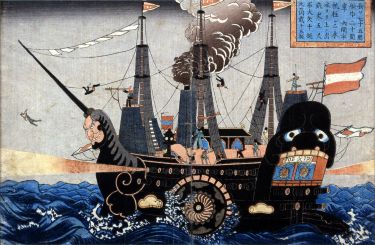Discover a new way of looking at Japanese history through the images made by those who were there. In this collaborative online course taught by MIT, Harvard, and Duke historians, you will examine Japan’s history through archival images now in the digital realm.
Digitization has dramatically altered historians' access to primary sources by creating large databases of the collected visual record. How is historical methodology changing in response to this seismic shift? How can scholars, students, and the general public make optimal use of these new digital resources?
In this online course, you'll look at methodologies historians use to “visualize” the past, exploring 1) themes of Westernization as seen in Commodore Perry’s 1853-54 expedition to Japan; 2) social protest in Tokyo’s 1905 Hibiya Riot; and 3) modernity, as seen in the archives of the major Japanese cosmetics company Shiseido.
Course Syllabus:
- Module 1: Black Ships & Samurai (Professor Dower). Examine and compare the visual representations left to us by both the American and Japanese sides of Commodore Matthew Perry's 1853-54 expedition that forced Japan to open its doors to the outside world. This module also addresses the rapid Westernization undertaken by Japan in the half century following the Perry mission.
- Module 2: Social Protest in Imperial Japan: The Hibiya Riot of 1905 (Professor Gordon). Discover a vivid and fresh perspective on the contentious domestic politics of an emerging imperial power through the dramatic daily reports from participants in the massive "Hibiya Riot" in 1905, the first major social protest in the age of "imperial democracy" in Japan.
- Module 3: Modernity in Interwar Japan: Shiseido & Consumer Culture (Professor Weisenfeld, with Professors Gordon and Dower). Exploring the vast archives of the Shiseido cosmetics company opens a fascinating window on the emergence of consumer culture, modern roles for women, and global cosmopolitanism from the 'teens through the 1920s and even into the era of Japanese militarism and aggression in the 1930s.




